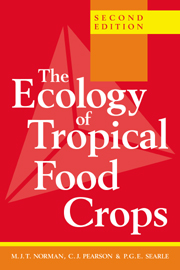9 - Crop legumes in tropical agriculture
Published online by Cambridge University Press: 05 June 2012
Summary
Introduction
This section of the book is concerned with the most important tropical food crops of the family Fabaceae: groundnut, common bean (Phaseolus vulgaris), soybean and chickpea. Other locally important tropical crop legumes include cowpea (Vigna unguiculata), concentrated largely in Nigeria; pigeonpea (Cajanus cajan) and the grams (V. mungo and V. radiata), grown mainly in India and southeast Asia; and hyacinth or lubia bean (Lablab purpureus), common in India and the Sudan. Adams & Pipolly (1980) give a useful general account of the biology of economic legumes.
Regional production
Table 9.1 gives the area, yield and production of tropical crop legumes. All pulses have been grouped together. Over half the world area sown to grain legumes is in tropical countries. Soybean and common bean (which is included among ‘other pulses’ in official statistics) are the most important tropical legumes, although groundnut is more specifically grown in tropical regions (Table 9.1). Tropical legumes contribute 35% to world production, which is higher than the comparable statistics for tropical cereals (30%, Table 4.1) but lower than for tropical root crops (40%, Table 14.1).
Production of crop legumes in tropical Asia equals that of Africa and America combined. The Asian figure would be further inflated if it were possible to include tropical soybeans in south China, which may amount to 7 m t of China's total soybean production of 9.8 m t per annum.
- Type
- Chapter
- Information
- The Ecology of Tropical Food Crops , pp. 185 - 192Publisher: Cambridge University PressPrint publication year: 1995
- 1
- Cited by



